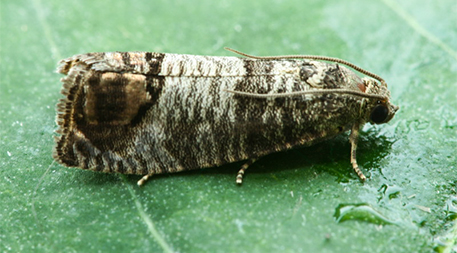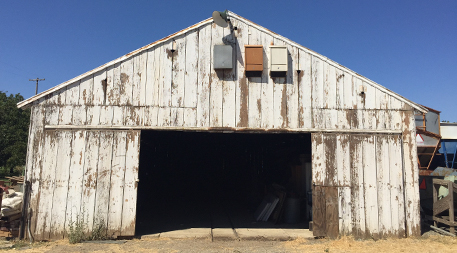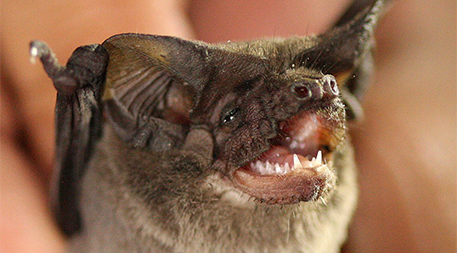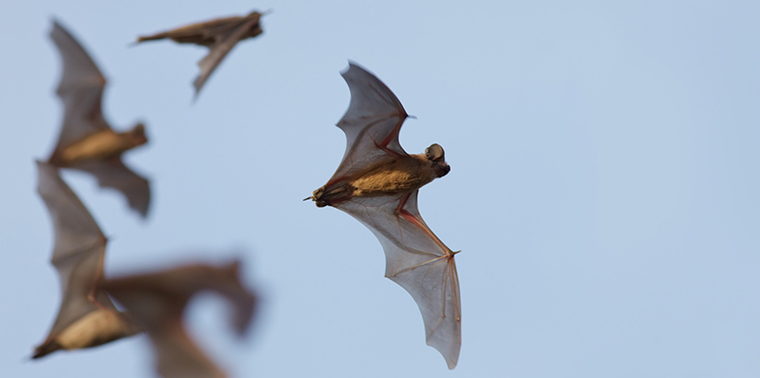September 21, 2015 — For the past three years, Katherine Ingram has had a most unusual summer job: catching bats and studying their droppings to see what they eat. A doctoral student in ecology at the University of California, Davis, Ingram is exploring the role bats can play as winged soldiers in the battle against a nonnative pest. Called a codling moth, the insect attacks California’s walnut crop, valued at nearly US$2 billion per year.
Some walnut farms report they lose up to 10 percent of their crop to the moths, whose larvae burrow into the soft shell and eat developing nuts. Adult moths lay eggs on the nutlets early in the growing season and produce as many as four generations each year. The cost of keeping the harmful insects at bay with synthetic pesticides — at least US$160 per acre — adds up, and conventional growers typically spray once or twice a year. Furthermore, the chemicals can wreak ecological havoc, blasting beneficial insects as well as the bad ones and throwing nature’s balance out of whack.

The codling moth, a nonnative insect, destroys up to 10 percent of the crop in some walnut orchards.Photo by Seabrooke Leckie (Flickr/Creative Commons).
Voracious insectivores, bats are known to have huge value in controlling crop pests generally: The economic return on their nighttime insect-eating services has been estimated at about US$23 billion per year for the U.S. alone, and research has shown that bats can help control pests in cotton fields and pecan groves in Texas, cornfields in the Midwest and rice fields in Thailand. But few studies have quantified how bats benefit individual crops and the farmers who grow them. Applying a mix of low-tech counting and high-tech genomics, Ingram is assessing the extent to which bats are consuming codling moths on various California walnut farms, and quantifying how conventional and organic growers who install bat houses on their farms reap potential savings from reduced insecticide use and crop loss to insects.
“Growers must make the land and these kind of practices work for them economically,” says Ingram. “Some growers definitely think that bats could have an impact on their bottom line by eating pests. … But if we can go beyond anecdotes and say for sure what the ecological and economic [benefit] is, that’ll go a long way.”

Housing boxes attached to a walnut orchard barn provide accommodations for hundreds of bats. Photo by Susan Moran.
Testing a Hunch
On a sweltering morning in July, Ingram dons a baseball cap that barely contains her long, wavy red hair and drives toward the rolling Coastal range to visit several of her 15 field sites. The walnut orchards she’s studying are scattered about the Sacramento Valley, where — along with the San Joaquin Valley — almost all U.S.-produced walnuts are grown.
By gathering a broader range of data over several years in more orchards under different conditions, Ingram hopes to determine to what degree bats are actually reducing moth populations. Ingram’s is the first comprehensive, multi-year comparison of the potential difference in bat activity (an indirect measure of insect-foraging activity) on walnut farms with and without bat houses. She set up four different treatments on the sites, which are all active commercial farms: conventional groves with bat houses, organic groves with bat houses, conventional groves without bat houses and organic groves without bat houses. Across the sites, she’s comparing the types of bat species present, their prevalence, foraging activity and the extent to which they consume moths. Ingram, also places codling moth traps in her test groves to determine how moth prevalence changes over time relative to bat activity. While Mexican free-tailed bat is most common in this region, Myotis, pallid, big brown and others are also prevalent, although it’s unclear whether they share a penchant for codling moths with the free-tailed.

Katherine Ingram inspects a codling moth trap to assess the presence of the pest at one of her study sites. Photo by Susan Moran.
By gathering a broader range of data over several years in more orchards under different conditions, Ingram hopes to determine to what degree bats are actually reducing moth populations. A previous study out of Sacramento State University found that bat colonies double their activity on farms when they roost in bat houses attached to barns near walnut orchards, but that study did not quantify the economic impact of employing bats as biological pest controls; at the time, the DNA technique to detect codling moth in bat diet had not yet been developed.
Claire Haag and her husband, Jim, like attracting bats as beneficial predators to their 70-acre walnut farm in the tiny town of Esparto near Davis. Some bats naturally roost in trees and other natural cavities, and hundreds of others have been drawn to the bat boxes the Haags have placed on the wall of their home. Claire has a strong hunch they’re helping keep codling moth populations down, although she’s unsure what the financial benefit is. She knows that a single bat can eat as many as 30 codling moths in one binge, and up to its entire body weight in insects in one night. But without a controlled study like the one Ingram is conducting, her hunch will remain just that.

Quick, agile and voracious, Mexican free-tailed bats can capture eat up to their weight in insects in a single night. Photo by J. N. Stuart (Flickr/Creative Commons).
“It’d be nice to know for sure,” she says. “And then people won’t just think we’re foolish [for using bat houses].”
Added Resilience
Codling moths were inadvertently introduced to the U.S. centuries ago from Europe and have afflicted apples, pears and walnuts ever since. Managing infestations has been difficult, with conventional chemical spraying being the most effective means. Non-chemical approaches to pest control — such as removing infested fruit on trees, releasing parasitoid wasps that attack moth eggs, and using pheromones that disrupt mating by preventing males from finding females — have been applied with limited success. Although chemical pesticides are effective, at least in the short term, they make some targeted species more resistant to pesticides, forcing growers to spray more and so pay more for moth control.
“If you increase diversity by relying on insects, bats, raptors, etc., you help strengthen your farming system.” — Rachael LongAt the Haags’ house, Claire walks to a porch, above which a thin, rectangular box about 2 feet tall is nailed to the wall 15 feet above the ground: the home of their collaborators in combating the codling moth. This kind of box can hold as many as 200 bats, Ingram says.
Rachael Long, Ingram’s research mentor and a farm advisor with the University of California Cooperative Extension, introduced bat boxes to area growers more than two decades ago. Based on research she conducted that showed bats feed on pests and help protect crops, more and more walnut growers are putting bat houses on their farms.
“There’s been a lot of interest in adding resilience into farming systems,” says Long, who also writes children’s books featuring a bat as the heroine. “If you increase diversity by relying on insects, bats, raptors, etc., you help strengthen your farming system.”
Buzz and Poop
To put a number to foraging activity, Ingram places recording devices on 10-foot poles among trees. The recorders capture the buzzy feeding calls of various species within a 10-meter radius — up to 1,000 calls a night. To show what the colony collectively eats, she gathers bat guano from beneath roosts and has it analyzed for the presence of moth DNA. She also catches individual bats in the dark of the night with a mist net, contains them in a perforated zip-close bag, waits for them to produce a fecal pellet, then takes their measurements and sets them free. Preliminary data show that roughly 10 percent of the samples from beneath Ingram’s bat roosts contain codling moth DNA.
Ingram notes that the research stands to benefit not only farmers but bats as well by putting an economic price tag on the services they provide.“With DNA analysis, we know not just that bats eat codling moths, but precisely how much of their diet is this moth,” says Ingram.
Once she brings the data from all of her tools together, Ingram plans to create an economic model that quantifies the financial benefits of applying bats to combat codling moths. Her hope is to be able to tell growers precisely how much bats can reduce codling moth populations, and thus how much money they can save by using bats more and chemical insecticides less. She also hopes her findings — if, indeed, they show that bats can adequately beat back the insects — will also help persuade state and federal policy makers to offer more financial incentives for growers to use pest control techniques that are healthier for ecosystems and humans.
Ingram notes that the research stands to benefit not only farmers but bats as well by putting an economic price tag on the services they provide, and so boosting their perceived value and, presumably, the desire to conserve them.
“Humans are not going away anytime soon,” she says, while driving back along dusty county roads to UC Davis after a morning in the field, “so we need to strike a balance between what we need and want and how we can give [wildlife] what they need within the human-modified habitat.” ![]()
Ensia shares solutions-focused stories free of charge through our online magazine and partner media. That means audiences around the world have ready access to stories that can — and do — help them shape a better future. If you value our work, please show your support today.
Yes, I'll support Ensia!
